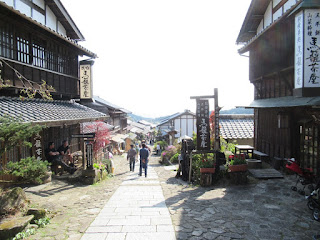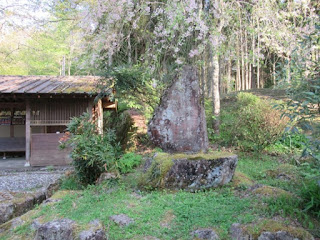Nakasendo
was also called Kiso-Kaido, as the Kiso Valley was the hardest-to-walk place in
all route from Edo (Tokyo) to Kyoto. There were 11 shukuba stations in Kiso – starting from Niegawa, the 33rd
station from Nihonbashi, to Magome, the 43rd station.
I
completed the walks through the 11 Kiso stations today.
Today’s
walk started from Midono, the 41st station. There were many tourists
who walks from Midono to Tsumago, the 42th station. I enjoyed beautiful flowers
while walking.
Tsumago
is one of most famous and popular shukuba
stations in Nakasendo. They started preserving and rebuilding old houses in the
1960s. The atmosphere of the Edo era remains. Now the place is widely known
among the tourists in the world. There were many foreign tourists here. (see also the 2nd and 3rd photo from the top)
Kiso
area has a long history of forestry. There were various conflicts between the
rulers and the ordinary people over the use of forestry resources. Such
memories were displayed at the historical museum.
There
was a craft man who wrote names, wishes and other information on requests on
the wood-made horses in the welcome center of Tsumago. It was unexpectedly
cheap. I got it for my souvenir.
The
services of the people to welcome tourists, or the software infrastructure of
tourism in other words, are wonderful in Tsumago -- I
got such impression here.
Nakasendo
goes into mountainous. I went through the Magome Pass before arriving in Magome,
the 43rd station.
There
is an observatory space just before entering into Magome station. I saw Mt. Ena
and other mountains.
Magome
is the birthplace of Shimazaki Toson, one of great novelists in the Meiji era.
His work “Yoake mae” (Before dawn) focuses on the moves in Magome and other
Kiso areas at the end of Edo era and the beginning of Maiji era. The conflicts
over the forestry resources (and the suppressions on people by both Tokugawa
shogunate government and the Meiji government) were described in the novel.
The
place of the main inn (honjin) is now
used for Shimazaki Toson Museum.
I
walked about 2 kilometers from Magome and found a monument, which tells “Kiso-ji
(Kiso road) begins here, goes northwords.”
There
is a stone-paved road between Magome and Ochiai, the 44th station. The
area is called the Ju-Magari Pass (the passes of ten corners).
I
arrived in Ochiai. It was a small shukuba. The gate and other parts of the main
inn were preserved.
It
was a long walk –nearly 30 kilometers – today.

















No comments:
Post a Comment